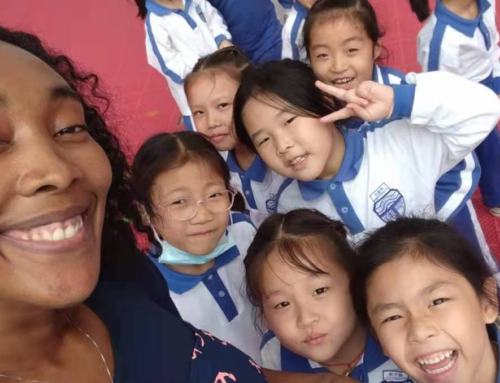Teaching young learners is particularly rewarding and fun, but it can also be a lot of work, especially when you can’t communicate with them in their native tongue. Whether you’re teaching preschool or kindergarten, grade 1, or even classes at a training center, teaching young learners presents a special set of challenges. When I began teaching kindergarten I thought it would be easy, but it was much more of a challenge than I initially thought it would be.
However, I also found it incredibly rewarding. Young children are learning and growing by leaps and bounds every single day, and as their teacher you get to take an active role in their discovery process! Additionally, you get so much love and hugs. To help you skip past the fear and dread and zoom straight into adoration and awe, I’ve compiled some tips that helped me teach young children.

Your Body is Your Best Tool
When you are teaching young children, your body is your best tool. Remember, they can’t understand much of what you say, but they understand your body movements. There are a number of ways you can use your body to engage better with kids, but the first and most important is to get on eye level with them.
Don’t just stand at the front of the classroom; get up to each student and crouch so you’re at eye level with them. Make sure you’re having personal interactions with each student, even if it’s a big class. This engages the students more, and it makes them pay attention. It also forges a connection between you.
It’s also important to do big actions and be silly! Make funny faces, fall off your chair, walk like a penguin, be weird. Being silly makes you more approachable, and it also makes you more engaging. And a student who isn’t engaged is a student who isn’t learning. Using big body language also helps children understand you, especially when their English vocabulary is limited.
Bodies are important for students, too! Make sure there’s lots of time for movement in your class. You can dance, do silly walks, touch your toes and stretch, and pat different body parts. This helps them get the wiggles out, and it also makes class more entertaining.
Use Rhythm and Rhyme
They say that humans are pattern-seeking creatures, and this can be seen especially in young learners. I use a lot of chanting and repetition in my class, and the children love it. Patterns are inherently comforting, and using chants and repetition is an easy way to give children the joy of learning what will come next.
You can use both visual and aural patterns in your classes. I teach colors, shapes, and patterns by cutting out different colors and shapes, and then creating patterns with them with the students (i.e. red circle, blue square, red circle, blue square). I also use clapping and stomping patterns where, for example, I clap a rhythm and they follow, to get students’ attention at the beginning of class and to get them to refocus during class.
If you want to teach a new sentence structure, you can even march around the classroom while you chant the sentence to the beat of your steps. If you can get your students to focus enough, you can even have them clap or use percussive instruments while they walk around! By engaging their whole body and having them follow a pattern, you get them to focus more wholly and make it easier for them to learn.
Use Your Imagination
With young children, you have endless possibilities for discovery and creativity. You can play pretend, act, and use real-life objects and props to learn! I love acting out “scenes” with my young students to learn new sentence structures, and the students love getting a chance to act for their peers. Also, it’s fun to use realia. If you’re learning about fruit, bring some fruit in! If you’re learning about clothes, bring in some sweaters and have students race to put them on!
Play is integral to children’s learning processes, and the more fun and interesting you make your class, the more enriching it will be. Don’t worry about being too silly or weird; the students will have a great time in whatever world you create in your classroom.
Independent play is also important for young learners. If you have the ability to decorate your own classroom, you can make it fun and inviting as well as interactive, inviting kids to explore independently! Velcro and felt are easy tools to create surfaces kids can play and learn with.
Don’t Sweat It!
The most important part of teaching small children is just to have fun and not worry! If you’re having a good time the kids will too, and they’re sure to love you!


















Leave A Comment